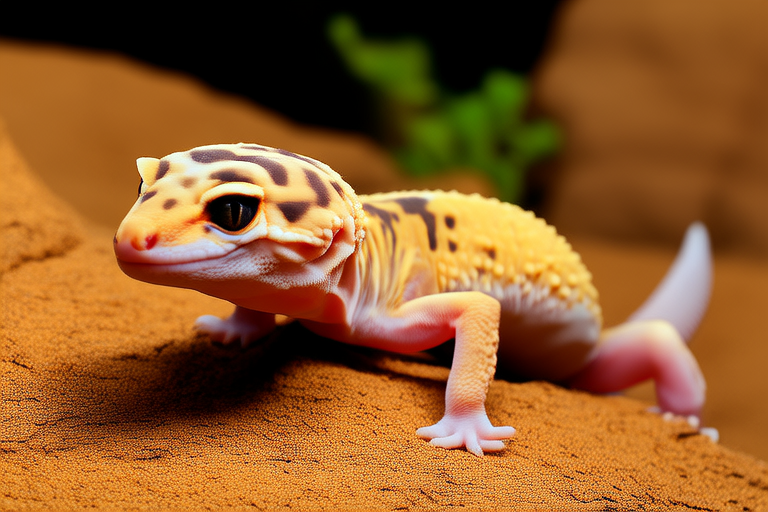Top 10 Myths About Leopard Geckos Debunked!
Leopard geckos have become one of the most popular pets among reptile enthusiasts due to their docile nature, ease of care, and vibrant colors. However, despite their growing popularity, many misconceptions still surround these fascinating creatures. Understanding the truth about leopard geckos is crucial for their well-being and for ensuring that they receive the proper care they need. This article aims to dispel some of the most common myths about leopard geckos and provide scientifically-backed information to help both novice and experienced owners.
Myth 1: Leopard Geckos Don’t Need UVB Lighting
The Myth: Many believe that leopard geckos can survive without UVB lighting because they are nocturnal animals.
The Reality: While it’s true that leopard geckos are primarily active at night, they still require UVB light for vitamin D3 synthesis, which aids in calcium absorption. According to Dr. Roger Klingenberg, a veterinarian specializing in reptiles, “Leopard geckos kept in captivity without UVB lighting may develop metabolic bone disease due to calcium deficiency.” It’s recommended to use low-level UVB lighting for 8-12 hours per day to ensure optimal health.
Myth 2: Leopard Geckos Can Hibernate
The Myth: Some owners mistakenly think that leopard geckos hibernate during colder months.
The Reality: Leopard geckos do not hibernate; instead, they undergo a period known as brumation. During this time, they reduce their activity levels but do not enter a deep sleep like mammals. Proper temperature control is essential to prevent stress and potential health issues. Experts recommend maintaining a consistent daytime temperature of around 88°F (31°C) and a nighttime drop to 70°F (21°C).
Myth 3: Leopard Geckos Only Eat Crickets
The Myth: There is a widespread belief that crickets are the sole diet for leopard geckos.
The Reality: A balanced diet is crucial for the health of your leopard gecko. While crickets are often part of their diet, it should be supplemented with other insects such as dubia roaches, mealworms, and waxworms. Nutritionally complete diets like Repashy Crested Gecko Diet can also be offered as a treat. Ensuring variety in their diet helps prevent nutritional deficiencies and promotes overall health.
Myth 4: Leopard Geckos Are Easy to Breed
The Myth: Some people assume breeding leopard geckos is straightforward and requires little effort.
The Reality: Breeding leopard geckos involves careful planning and specific environmental conditions. Temperature, humidity, and photoperiod all play significant roles in stimulating reproductive behavior. Additionally, proper nutrition is vital for successful breeding. It’s advisable to consult with experienced breeders or veterinarians before attempting to breed leopard geckos to avoid potential complications.
Myth 5: Leopard Geckos Don’t Need Water Bowls
The Myth: There’s a misconception that leopard geckos don’t drink water.
The Reality: Leopard geckos obtain much of their moisture from the food they eat, particularly live insects. However, providing a shallow water bowl is still important, especially during shedding periods when increased hydration can help. Regularly cleaning the water bowl prevents bacterial growth and keeps the environment hygienic.
Myth 6: Leopard Geckos Require Frequent Handling
The Myth: Some owners believe that frequent handling is necessary to socialize their leopard gecko.
The Reality: Leopard geckos are naturally shy and prefer minimal handling. Overhandling can cause undue stress and lead to behavioral changes. It’s best to handle them gently and infrequently, allowing them time to acclimate to their surroundings. Gradually increasing interaction can help build trust, but always respect their boundaries.
Myth 7: Leopard Geckos Don’t Shed Their Tails
The Myth: Many believe that leopard geckos cannot shed their tails.
The Reality: Leopard geckos, like many other lizards, can voluntarily shed their tails in response to stress or danger. This process, known as autotomy, allows them to escape predators. The tail will eventually regrow, but it may not look identical to the original. To minimize tail loss, create a stress-free environment and avoid handling the gecko roughly.
Myth 8: Leopard Geckos Can Live Without Sand Substrate
The Myth: Some owners think that sand substrate is harmful and unnecessary for leopard geckos.
The Reality: While it’s true that certain types of sand can pose risks, such as impaction, there are safer alternatives available. Reptile-safe substrates like coconut fiber, paper towels, and indoor/outdoor carpeting are excellent choices. These substrates offer a more natural environment while reducing the risk of health issues associated with traditional sand.
Myth 9: Leopard Geckos Are Low Maintenance Pets
The Myth: There’s a perception that leopard geckos require minimal attention.
The Reality: While leopard geckos are relatively easy to care for compared to some other reptiles, they still need regular maintenance. This includes cleaning their enclosure, monitoring their diet, and providing appropriate temperatures and humidity levels. Regular veterinary check-ups are also recommended to ensure their continued good health.
Myth 10: Leopard Geckos Are Nocturnal, So They Don’t Need Heat
The Myth: Some owners assume that since leopard geckos are nocturnal, they don’t need heat during the day.
The Reality: Leopard geckos rely on external heat sources to regulate their body temperature. Maintaining a warm basking area and a cooler side within their enclosure is essential for their digestion and overall health. Providing a thermal gradient allows them to thermoregulate effectively, even though they are primarily active at night.
Conclusion
In conclusion, understanding the truth behind common myths about leopard geckos is vital for their well-being and the satisfaction of their owners. By addressing these misconceptions and providing scientifically-backed information, we hope to encourage responsible pet ownership. Remember, a healthy and happy leopard gecko depends on proper care, including appropriate diet, habitat setup, and regular veterinary check-ups. With the right knowledge and dedication, you can ensure your leopard gecko enjoys a long and fulfilling life.
